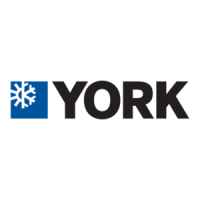JOHNSON CONTROLS
187
SECTION 9 – SERVICE AND TROUBLESHOOTING
FORM 150.67-NM2
ISSUE DATE: 01/31/2019
9
TROUBLESHOOTING (CONT’D)
PROBLEM CAUSE SOLUTION
“Low Liquid Temp” Fault 1. Improperly adjusted leaving chilled
liquid temp. cutout (glycol only)
2. Micro panel setpoint/range values
improperly programmed.
3. Chilled liquid ow too low.
4. Defective LWT or RWT sensor (as-
sure the sensor is properly installed
in the bottom of the well with a
generous amount of heat conductive
compound).
1. Re-program the leaving chilled liquid
temp. cutout.
2. Re-adjust setpoint/range.
3. Increase chilled liquid ow-refer to
limitations in installation section.
4. Compare sensor against a known
good temperature sensing device.
Refer to service section for temp./
voltage table.
“MP / HPCO” Fault 1. Compressor internal motor protector
(MP) open.
2. External overload tripped.
3. HPCO switch open.
4. Defective HPCO switch.
5. Defective CR relay.
1. Verify refrigerant charge is not low.
Verify superheat setting of °10–15°F
(5.6°–°C). Verify correct compressor
rotation. Verify compressor is not
over loaded.
2. Determine cause and reset.
3. See “High Press. Disch.” Fault.
4. Replace HPCO switch.
5. Replace relay.
Compressor(s) Won’t Start 1. Demand not great enough.
2. Defective water temperature sensor.
3. Contactor/Overload failure.
4. Compressor failure.
1. No Problem. Consult “Installation”
Manual to aid in understanding
compressor operation and capacity
control.
2. Compare the display with a thermom-
eter. Should be within +/- 2 degrees.
Refer to service section for RWT/
LWT temp./voltage table.
3. Replace defective part.
4. Diagnose cause of failure and re-
place.
Lack of Cooling Effect 1. Fouled evaporator surface. Low suc-
tion pressure will be observed.
2. Improper ow through the evapora-
tor.
3. Low refrigerant charge. Low suction
pressure will be observed.
1. Contact the local Johnson Controls
representative.
2. Reduce ow to within chiller design
specs. See limitations in Installation
section.
3. Check subcooling and add charge as
needed.
TABLE 37- TROUBLESHOOTING (CONT’D)

